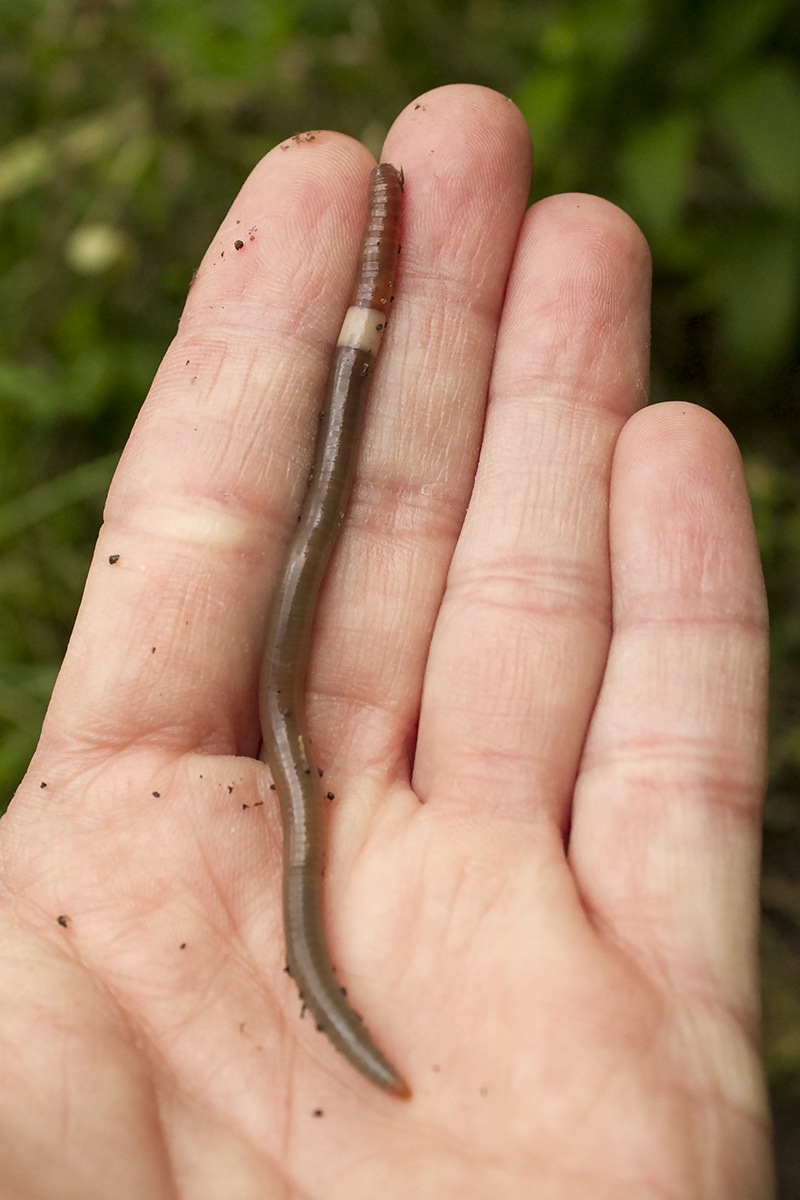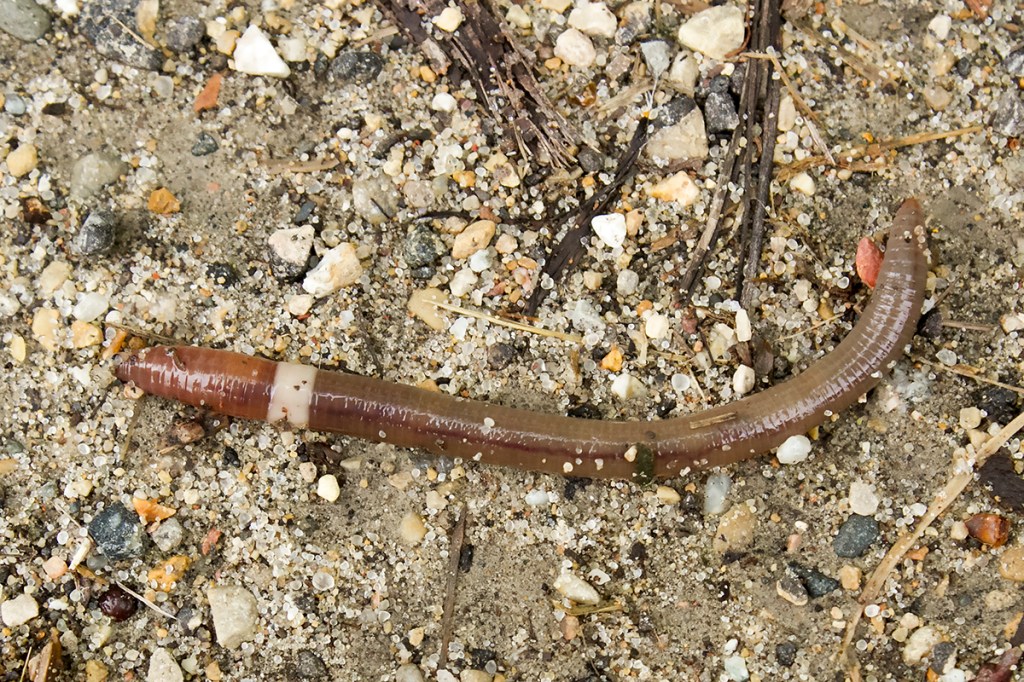Disturb a jumping worm and it’s like a nightcrawler on steroids: It violently writhes on the forest floor, recalling a snake in a bad horror movie. Try to catch it, a piece of its tail will detach in your hand — still wriggling as you hold it.
But put aside the creepy factor: jumping worms may be the next big threat to northern forests.
Jumping worms, consisting of various non-native species from multiple genera, have become established in a number of eastern and southeastern states. In 2013, species from the genus Amynthas were confirmed for the first time in the Upper Midwest, at the University of Wisconsin-Madison Arboretum.
In the forests and prairies of the Upper Midwest, the jumping worm could significantly alter habitats and decrease biodiversity. Why are they so damaging? And is there anything we can do to stop them?
Why Much of What You Know About Earthworms is Wrong
You probably learned about the wonders of earthworms at an early age. They aerate the soil. They help your garden grow. And they catch fish. The humble earthworm is a creature to celebrate.

Overlooked in all this earthworm love is an important fact: in a significant portion of the North American continent, no native earthworms have existed since before the Ice Age. As such, forests and other habitats have evolved without them.
But people love earthworms. They indeed use them by the millions for fishing, and for composting, and to help gardens grow. And so the worms have been spread far and wide. Even areas with native earthworms have largely been taken over by non-native varieties. The common nightcrawler — familiar to anyone who has ever cast a bobber and hook — is a European species.
Earthworms have also spread into the northern habitats where worms have been absent for thousands of years. The hype is true: earthworms cycle through a lot of refuse, and fundamentally change the soil. This may be good in your backyard garden plot, but it’s not in the northern forest.
“Earthworms change the environment to suit their needs,” says Brad Herrick, ecologist and research program program manager at the University of Wisconsin-Madison Arboretum. “When they are introduced, they make a host of physical, chemical and biological changes to the soil environment.”
Essentially, worms turn the forest floor — a complex community of plants, invertebrates and microbes – into a completely different habitat.
The jumping worm, if established in the Upper Midwest, brings new threats. “We think the changes to native habitats will be similar to other earthworms but even more dynamic,” says Herrick.
Spread of the Jumping Worm
You probably think of earthworms as living underground. But the jumping worm actually lives in the topmost layer of the forest floor — amongst the fallen leaves and other material that cover the soil. It eats that fallen organic material. And that’s the problem.
That leaf litter provides essential nutrients to the forest. Trees need long-lasting sources of nutrients. When jumping worms quickly turn leaves into very loose soil (resembling coffee grounds), they deprive trees of essential nutrients.
They thus can inhibit the establishment of tree seedlings. The altered soil is inhospitable to many native plant species. And that soil also disrupts the relationships between fungi and trees.
In short, the jumping worm could have profound effects on the overall forest ecosystem.
As with so many invasive species, they’re adaptable and difficult to stop. They’re parthenogenetic: they can reproduce without fertilization. The introduction of a single individual is enough to launch a jumping worm invasion.
The worms have an annual life cycle. They die in the fall, but leave tiny cocoons that spend the winter in the soil.
And they can be spread readily by human habits. Take their preferred habitat of fallen leaves. At this time of year, many people are raking leaves into a pile and setting them by the road to be picked up or converted into mulch. The worms — or their cocoons — are thus transported to new habitats. Compost and potted plants can also move the worms around.
“Unfortunately at this time, there are no good control measures,” says Herrick. “The important thing now is to the stop the spread. Everyone can help.”
Stop the Jumping Worm
Herrick and other conservationists agree that prevention is the most effective tactic. If you live in the Upper Midwest, and see a writhing, snake-like earthworm in your backyard, report it to your state natural resources department. (In Wisconsin, you can email invasive.species@wi.gov to report sightings).
The Wisconsin Department of Natural Resources also has a handy identification card to help you distinguish the jumping worm from the common nightcrawler.
Wisconsin DNR also suggests examining potted plants and gardening and landscaping materials for the presence of jumping worms. If you are doing landscaping and gardening work, be sure to clean your equipment and clothing to prevent transporting cocoons.
And if you buy compost, only buy from sources that heat the compost at appropriate temperatures and duration to kill pathogens.
The jumping worm is not yet established in much of the northern United States. The time is now to keep it from becoming the next invasive species horror story.




My soul has turn SO soft even in the dry summer moths the lawn mower sinks in the dirt .
As in your discussion about , soil resembles coffee grinds . Grass has a hard time taking root .
I’m not sure if the problem is the jumping worms or just common night crawler ? How do you kill off the jumping worm ? I’m from northern NJ .
My cat has apparently ate some of these jumping worms,
How do I safely dewormi her with what home remedy if possible8tammisharp
If your cat ate jumping worms, they would die in her digestive system. They are earthworms, not a parasitic species. I would contact a veterinarian if your cat has parasitic worms.
Thank you for your helpful info on these invasive worms. I just found that most of my potted plants contain them :(. I am trying to avoid losing all of that soil, though haven’t found a way of treating/saving the soil without throwing away the whole lot of it and starting over. The REAL concerning problem is that I only used purchased soil and that is surely where these worms came from. Now going to have to purchase sterilized soil and amend myself.
I believe that I have been startled by these invasive jumping worms. Can you tell me about the appearance of their eggs? Are they tiny, white orbs found not deep underground?
I live in coastal Massachusetts.
Thank you, Sandra
I found this worm in my mulch pile when i was looking for fish worms people knew about the worm but didn’t know anything about it
We added a goodly amount of organic compost to our garden and mulched our flower beds heavily. I noticed as I weeded between landscaping pavers and especially in the newly mulched areas, that the worms were very close to the surface, and at times, I would jump thinking it was a snake, because it would move so quickly. I began to see information too late. I am hoping that I was mistaken. I live in the Catskill Mountains in New York State.
Instead of using slow release fertilizer this Spring, What can be added to the depleted soil to help the plants? composted manure or mushroom compost?
I live in central Florida, I am almost positive I found jumping worms. Where can I send you pictures
I live in ct.these are everywhere when I blow or rake off some leaves you see hundreds of these writhing and twisting around and lots of that coffee grounds looking soil. I’m having a difficult time understanding how this soil isn’t full of nutrients that could be leached down to the roots of trees like maple cherry oak and ash. I have lived here since 1990 and I can assure you that these hardwoods are growing well and looking good. The understory is all non native shrubs like barberry honeysuckle euonymus. And periodic flushes of garlic mustard
I learned about the jumping worms just recently on a Facebook article. I live in southern Connecticut and they are all over my acre and one half yard. We also have the Emerald Ash beetle and the Gypsy Moth caterpillar. We have Zebra mussels in the lakes and a blight that is killing hemlock trees. We have invasive Fragmite and a species Pigweed have been spotted in out state. BUT WHAT CAN WE DO??? They are all here and everywhere I look. There are hundreds of dead trees and now the mountain laurel is dying too. The lakes are clogged with Zebra mussels which get into the boat engines and hydro electric dams. They are ruining the eco system in all our waterways. Why are all these invasive things suddenly coming into our country? There seems to be nothing we can effectively do to stop any of this.
I live in central New York. I have just raked a small backyard area and have about thirty of these worms in a bucket. When do they reproduce (leave their cocoons)? If I kill them, can I compost the dead worms?
Hi Nancy,
If you are finding adults, they are probably already reproducing. I would make sure the worms are indeed dead before composting. Many worms can live even if cut up. Disposal would be a safer option. Thanks for reading. Matt
Have them in Dixon Il. All over my gardens. Very few regular worms spotted.
My garden is full of them. Don’t know how they got here. How do you kill them. I tried cutting them in half with my shovel but they are too quick.
I just read an article on this species of worm in the Chicago Tribune today. So I googled it. Here is my story.I was doing some landscaping in Lake Geneva Wisconsin at my summer home last weekend.I love to fish.So I was saving the worms that I dug up , but they were different. They were extremely wiggly and hard to put in a container. They were firmer than a regular worm and fatter. The bigger ones would break off when handled. And they seemed to be dying in the container the next day. The fish still like them but I through them out after a day or two. It made me wonder about these worms. But after reading this article , I think maybe this is that invasive species of worm. Am I right? Laura Knop
What if a pet is intrigued by their movement and eats one?